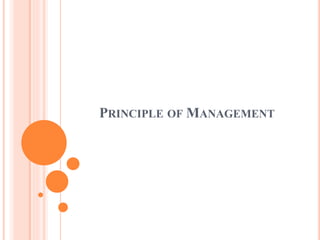
Principle of Management Unit 5.pptx
- 2. 1.What is Controlling? 2.Importance of Controlling 3.Features of Controlling 4.Process of Controlling Communication 1.What is Communication? 2.Importance of Communication in Management 3.The 7 Characteristics of Effective Communication 4.Communication Process 5.Types of Communication 6.Barriers of Communication Outlines: Unit 05 Management-Controlling & Communication
- 3. 1.What is Controlling? Controlling can be defined as that function of management which helps to seek planned results from the subordinates, managers and at all levels of an organization. The controlling function helps in measuring the progress towards the organizational goals & brings any deviations, & indicates corrective action. Controlling helps managers monitor the effectiveness of their planning, organizing, and leading activities.
- 4. 2.Importance of Controlling A good control system helps an organization in the following ways: Accomplishing Organizational Goals The controlling function is an accomplishment of measures that further makes progress towards the organizational goals & brings to light the deviations, & indicates corrective action. Judging Accuracy of Standards A good control system enables management to verify whether the standards set are accurate & objective. Making Efficient use of Resources The resources are used in the most effective & efficient manner for the further availability of resources. Improving Employee Motivation Ensures each employee knows well in advance what they expect & what are the standards of performance on the basis of which they will be appraised.
- 5. Ensuring Order & Discipline Controlling creates an atmosphere of order & discipline in the organization which helps to minimize dishonest behavior on the part of the employees. Facilitating Coordination in Action Each department & employee is governed by such predetermined standards and goals which are well versed and coordinated with one another.
- 6. 3.Features of Controlling An effective control system has the following features: 1.It helps in achieving organizational goals. 2.Facilitates optimum utilization of resources. 3.It evaluates the accuracy of the standard. 4.It also sets discipline and order. 5.Motivates the employees and boosts employee morale. 6.Ensures future planning by revising standards. 7.Improves overall performance of an organization. 8.It also minimises errors. Note: Controlling and planning are interrelated for controlling gives an important input into the next planning cycle. Controlling is a backwards-looking function which brings the management cycle back to the planning function. Planning is a forward-looking process as it deals with the forecasts about the future
- 7. 4.Process of Controlling Control process involves the following steps as shown in the figure: Establishing standards: This means setting up of the target which needs to be achieved to meet organisational goals eventually. Standards indicate the criteria of performance. Control standards are categorized as quantitative and qualitative standards. Quantitative standards are expressed in terms of money. Qualitative standards, on the other hand, includes intangible items.
- 8. Measurement of actual performance: The actual performance of the employee is measured against the target. With the increasing levels of management, the measurement of performance becomes difficult. Comparison of actual performance with the standard: This compares the degree of difference between the actual performance and the standard. Taking corrective actions: It is initiated by the manager who corrects any defects in actual performance.
- 9. 1.What is Communication? Communication is simply the act of transferring information from one place, person or group to another. Communication is the act of giving, receiving, and sharing information Communication serves five major purposes: to inform, to express feelings, to imagine, to influence, and to meet social expectations. Each of these purposes is reflected in a form of communication.
- 10. 2.Importance of Communication in Management 1. Basis of Decision-Making and Planning 2. Smooth and Efficient Working of an Organisation 3. Facilitates Co-Ordination 4. Increases Managerial Efficiency 5. Promotes Co-operation and Industrial Peace 6. Helps in Establishing Effective Leadership 7. Motivation and Morale 8. Increases Managerial Capacity 9. Effective Control 10.Job Satisfaction 11.Democratic Management 12.Increases Productivity and Reduces Cost 13.Public Relations
- 11. 3.The 7 Characteristics of Effective Communication
- 12. 4.Communications Process •Sender: The person delivering the message •Receiver: The person getting the message •Message: The information the sender is relaying to the receiver •Communication channel: The method used to transmit a message •Decoding: Interpreting the message, done by the receiver •Encoding:certain words or non-verbal methods such as symbols, signs, body gestures, etc. to translate the information into a message. •Feedback: When applicable, a response sent back to the sender
- 14. Intrapersonal Communication: It may take place within an individual, it is talking to oneself in one’s own mind. Transpersonal Communication: It takes place within a person’s spiritual domain. Interpersonal Communication: It is an exchange of information, ideas, and feelings between two people through verbal or non-verbal methods. Group Communication: Group communication is the act of sending and receiving messages to a number of people called group members. Mass Communication: Mass communication is the process of imparting and exchanging information through mass media to large segments of the population.
- 15. 6.Barriers of Communication The barriers to communication can be broadly classified as: 1.Semantic Barriers 2.Psychological Barriers 3.Organisational Barriers 4.Personal Barriers
